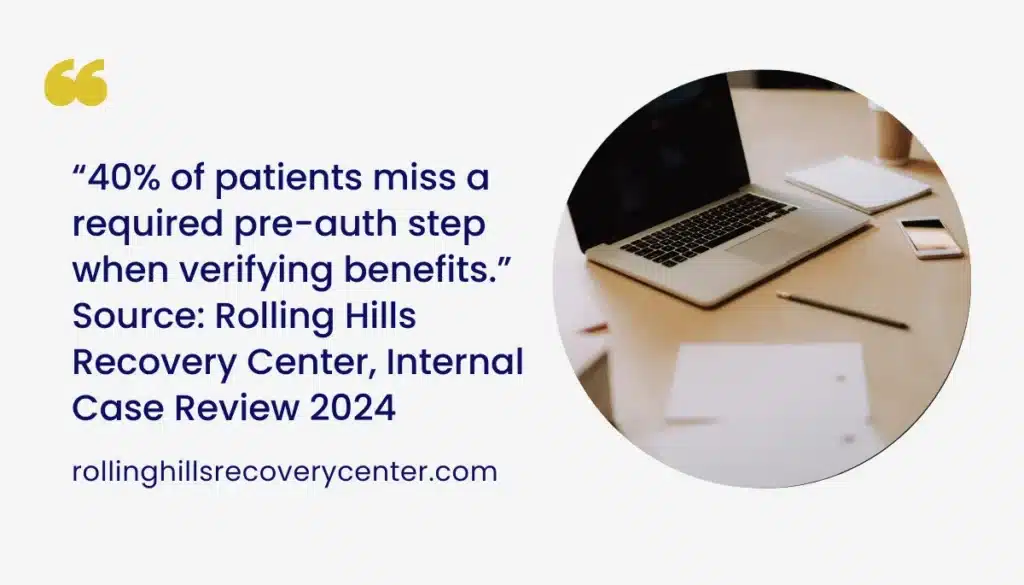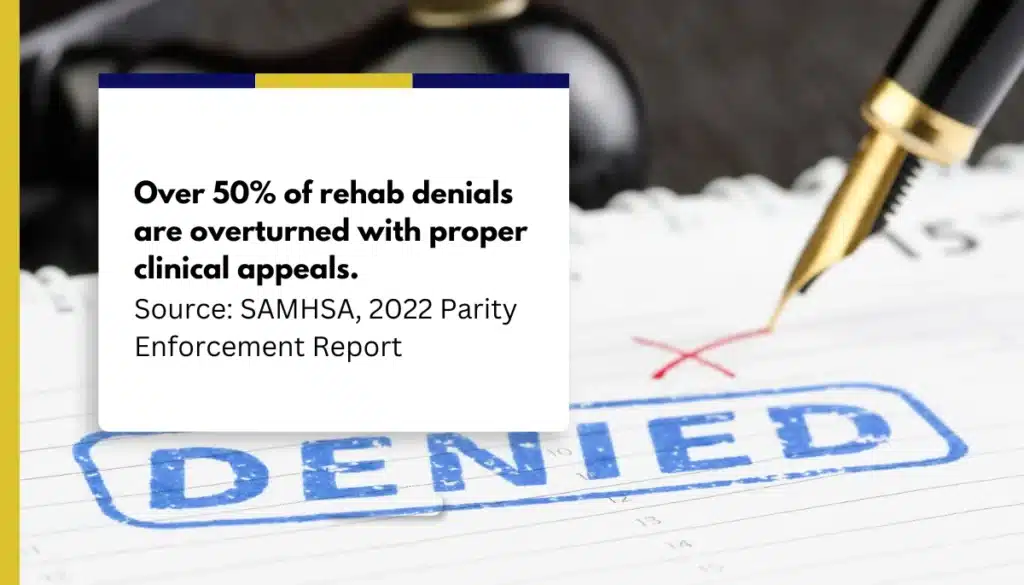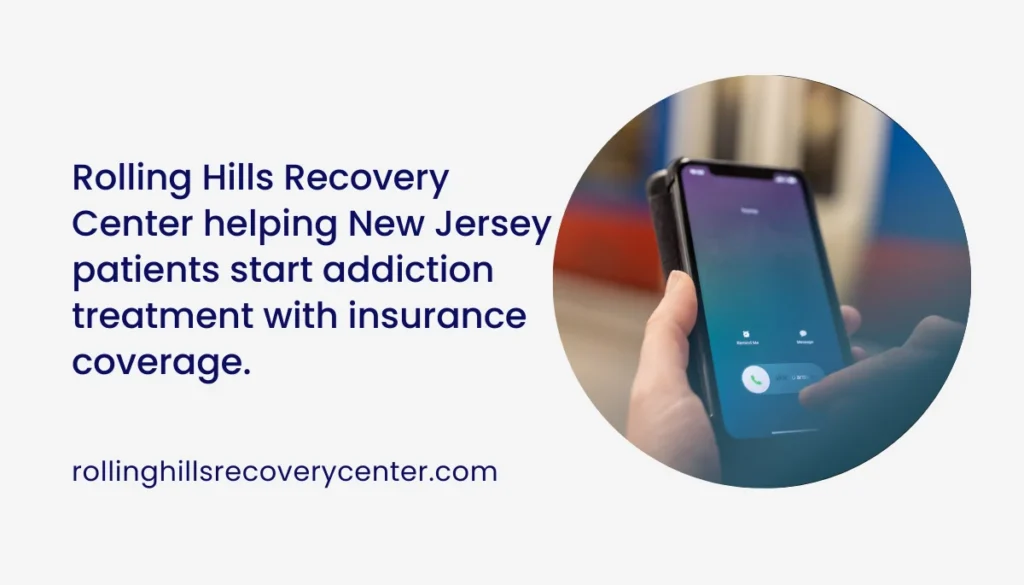As a leading substance abuse treatment center in New Jersey, we’re often asked how insurance covers addiction treatment. Below, we explain what plans usually include, how to check your benefits, and what to know about authorizations, costs of rehab, and appeals under state and federal rules. The aim is to help you start care promptly and avoid billing surprises.

Key Takeaways
- Most plans cover substance use treatment due to the ACA and MHPAEA; coverage depends on medical necessity, network status, and prior authorization.
- Verify benefits fast: use your member portal, then call the number on the back of the card to confirm in-network options, ASAM level coverage (detox, residential, PHP, IOP), costs, and any pre-cert. Get names & reference numbers.
- Expect a deductible, then coinsurance or copays until you reach your out-of-pocket max; in-network cuts costs, while out-of-network can bring balance billing unless there’s OON benefits or a single-case agreement.
- If a denial happens, request the written decision, file an urgent internal appeal with strong clinical notes (ASAM severity, risks, what’s already tried), and escalate to external review in New Jersey when eligible. Keep timelines and docs.
What Types of Insurance Typically Cover Rehab and the Laws That Require It
We first look at the type of plan you have. That determines what rules apply and how coverage works. Most plans like Aetna, Blue Cross Blue Shield, Cigna, and UnitedHealthcare do cover substance use disorder (SUD) treatment, but the details vary.
Affordable Care Act (ACA) Essential Health Benefits
- Individual and small-group plans sold on or off the Marketplace must cover mental health and substance use disorder services as essential health benefits.
- They also must follow parity (see below). This includes services like detox, inpatient/residential, partial hospitalization (PHP), intensive outpatient (IOP), outpatient therapy, and medications for addiction treatment (MAT) such as buprenorphine or naltrexone.
Helpful reference: Healthcare.gov’s page on mental health and substance use disorder coverage outlines these protections and benefit types: Healthcare.gov: mental health and substance use disorder coverage
Mental Health Parity and Addiction Equity Act (MHPAEA)
- Parity requires that SUD and mental health benefits are no more restrictive than medical/surgical benefits in the same plan. It applies to most employer plans, Marketplace plans, and many others.
- Parity touches co-pays, prior authorization, medical necessity standards, provider networks, and more. If you feel your SUD care has tougher rules than comparable medical care, that may be a parity issue.
Parity resources and your rights are summarized by the U.S. Department of Labor: MHPAEA resources.
Self-Funded Employer Plans vs Fully-Funded Insured Employer Plans
- Self-funded (ERISA) plans: Your employer pays claims directly. These follow federal rules (MHPAEA) and are overseen mostly by the U.S. Department of Labor. State laws, like some New Jersey mandates, usually do not apply to self-funded plans.
- Fully insured plans: The insurance company takes on the risk, and the plan is regulated by the state. In New Jersey, fully insured plans must follow state rules in addition to federal parity.
If you are unsure which one you have, ask your HR benefits lead or check the Summary Plan Description (SPD).
Medicare Basics
- Medicare covers SUD treatment in hospital and outpatient settings when medically necessary, including detox, medications, and partial hospitalization through Part A and/or Part B. Part D can cover FDA-approved medications for addiction when criteria are met.
- Medicare Advantage plans (Part C) must cover at least the same level of medically necessary SUD services as Original Medicare, but they may have network rules and prior authorizations.
Medicaid Basics (New Jersey FamilyCare)
- New Jersey FamilyCare (Medicaid) covers a full continuum of SUD services, usually through managed care organizations (MCOs). Coverage can include withdrawal management (detox), residential, PHP, IOP, outpatient, and MAT.
- You will want to confirm the MCO’s network and any prior authorization requirements for ASAM levels of care.
New Jersey-Specific Protections
- New Jersey has additional consumer protections for fully insured plans, and DOBI (Department of Banking and Insurance) regulates those plans. The state has taken steps over the years to improve access to opioid use disorder treatment, reduce prior authorization barriers for the start of care, and support MAT access. The exact rules that apply to you depend on your plan type.
- New Jersey’s external review and appeal processes apply to fully insured plans; self-funded plans follow federal processes, but you may still use DOBI for information and direction.
At Rolling Hills Recovery Center, we work with many plan types and stay current with parity requirements and New Jersey rules, so we can help you understand what applies to you quickly.

How to Verify Your Benefits Step by Step
When we verify benefits with a patient, we follow a simple workflow. You can do this yourself, or we can help.
Step 1: Gather Your Documents
- Member ID card (front and back).
- Full legal name, date of birth, and address on file with the plan.
- Plan documents: Summary of Benefits, Summary Plan Description (SPD) for employer plans, or Evidence of Coverage.
- A pen and notebook or a digital note, you will record every detail.
Step 2: Log In To Your Insurer Portal
- Create or log in to your member account.
- Confirm eligibility (active coverage) and the plan year dates.
- Review the benefits for mental health and substance use disorder. Look for levels of care: detox/withdrawal management, residential/inpatient, PHP, IOP, outpatient, MAT.
- Check if preauthorization is required for each level.
Tip: Download your Summary of Benefits so you have the co-pays, deductible, coinsurance, and out-of-pocket maximum handy.
Step 3: Call the Number on the Back of Your Card
Ask for Behavioral Health or Substance Use Services. Use this script and do not hesitate to pause and write down answers.
Suggested script:
- “I am calling to verify my benefits for substance use disorder treatment. May I have your name and a reference number for this call?”
- “What are my in-network benefits for ASAM levels of care: detox (Level 3.7/4), residential (3.1–3.7), PHP (2.5), IOP (2.1), and outpatient?”
- “What about out-of-network benefits for these levels? Are there any exclusions?”
- “Do these services require prior authorization or notification? For which levels? Who submits it? Is concurrent review required, and how often?”
- “What medical necessity criteria do you use, ASAM criteria, MCG, InterQual? Can you send me a copy or a link?”
- “Are there day limits or visit caps? Any frequency limits?”
- “What are my cost-shares: deductible, coinsurance, and copays? What is my out-of-pocket maximum for the year?”
- “Can I be assigned a care manager or case manager right now?”
- “If the nearest in-network program cannot admit me soon, can you authorize a single-case agreement with an out-of-network facility to avoid delay?”
- “How long do authorizations usually last, and how do I extend them if my clinician says I still meet criteria?”
- “What is the process for urgent prior authorization? What is the turnaround time?”
- “Please confirm your fax number and secure portal for clinicals, in case my provider needs to submit documents.”
- “Can you email or mail me a written summary of these benefits?”
Record the representative’s name, the date and time, and the reference number.
Step 4: Confirm In-Network vs Out-of-Network
- Ask for a list of in-network programs that can do detox, residential, PHP, and IOP within a reasonable distance.
- If your clinical need is urgent and network access is limited, ask whether the plan can approve an out-of-network placement at in-network benefit levels (a single-case agreement).
- At Rolling Hills Recovery Center, we verify insurance benefits and work with your plan to find the best-fit level of care based on ASAM criteria.
Step 5: Clarify Prior Authorization and Concurrent Review
- Prior authorization: Get the exact steps. Who requests it? What documents are needed?
- Concurrent review: Many plans require updates every few days during residential or PHP. Ask the frequency (every 3–7 days is common) and what info they need (urine tox screens, vitals, withdrawal scales, therapy notes, ASAM dimensions).
- Ask where denial notices are sent and how quickly you and your provider will be notified.
Step 6: Document Everything
- Keep a running log of dates, names, and call reference numbers.
- Save PDFs of benefits and any emails.
- If anything is unclear, ask the plan to send it in writing.
What You Will Likely Pay: Deductibles, Coinsurance, Copays, and Out-of-Pocket Limits
Coverage does not mean free care. Your cost depends on your plan’s design. Here is the usual sequence:
- Deductible: You pay 100% of allowed charges until you meet the deductible (except some plans use copays or waive the deductible for certain services).
- Coinsurance: After the deductible, you pay a percentage of allowed amounts, e.g., 20%.
- Copays: Some plans charge a fixed copay per day or per visit, especially for outpatient and IOP.
- Out-of-pocket maximum: Once you hit this yearly cap, covered in-network services should be paid at 100% by the plan for the rest of the plan year.
Out-of-network risks:
- Balance billing: OON providers can bill you the difference between their charge and the insurer’s allowed amount unless protections apply. Ask the provider up front.
- Higher deductibles and coinsurance often apply OON, and authorizations can be stricter.
Pre-certification vs notification:
- Pre-certification (prior authorization) is an approval needed before admission. Notification is simply informing the plan, but not asking permission. Know which one your plan requires for each level.
Single-case agreements (SCA):
- If the in-network network is inadequate or time sensitive, the plan may offer an SCA for an out-of-network facility at in-network rates for a specific episode of care. Your provider usually initiates this.
Reading Your Explanation of Benefits (EOB)
When claims process, you receive an EOB (not a bill) that shows:
- Billed charge
- Allowed amount
- What the plan paid
- Your responsibility (deductible, coinsurance, copay)
- Denial reason codes if applicable
If anything looks off, call the plan and the provider’s billing team. Sometimes coding updates or an authorization number needs to be added.
Common Denial Reasons and Fast Fixes
- No prior authorization on file: Ask your provider to submit a retro-authorization with clinical notes. Some plans allow this within a short window.
- Medical necessity not met: Provide a clinician’s letter summarizing ASAM criteria, withdrawal risk, psychiatric comorbidity, failed lower levels of care, and why step-down is unsafe.
- Out-of-network when in-network exists: If no timely in-network bed was available, submit documentation of your network outreach attempts and timelines, plus clinical urgency.
- Administrative errors: Wrong member ID, wrong taxonomy code, missing modifier. These can be corrected by the provider and resubmitted.
We routinely support patients by preparing strong clinical notes and speaking with utilization reviewers to prevent or overturn avoidable denials.

New Jersey Rights and Timelines: Authorizations and Appeals
New Jersey has clear processes for complaints, appeals, and external reviews, especially for fully insured plans. Self-funded plans follow federal timelines, but urgent standards are similar.
Urgent Prior Authorization Timelines
- Urgent prior authorization and urgent internal appeals are typically decided within about 72 hours. If a decision would seriously jeopardize your health or ability to regain maximum function, it should be treated as urgent.
- Ask your plan how to label the request “urgent” and what documentation they need to meet the 72-hour clock.
Internal Appeals Windows
- You generally have at least 180 days to file an internal appeal after an adverse benefit determination (denial). Check your plan for exact deadlines and whether there are one or two levels of internal appeal.
- For urgent appeals, call and fax the appeal the same day you receive a denial.
Marketplace plan appeal steps are explained at Healthcare.gov: appeal a health plan decision.
External Review Eligibility
- After you lose an internal appeal (or if the plan waives it), you may qualify for an independent external review. In New Jersey, this is administered under DOBI for fully insured plans and certain others.
- External review is binding on the insurer in most cases.
New Jersey instructions and forms are at the NJ Department of Banking and Insurance: Health Plan Appeals.
How to File with NJ DOBI and What to Include
For a strong packet, include:
- A brief clinical summary by your treating clinician: diagnosis, ASAM severity across all dimensions, risk of relapse/overdose, medical and psychiatric comorbidities, past treatment attempts, response to care, and why the requested level is necessary now.
- All denial letters: Ask the plan for a written “adverse benefit determination.”
- Benefit documents: relevant sections of your policy, parity language if available.
- Progress notes, withdrawal scales (e.g., CIWA/COWS), tox screens, and physician orders.
- A parity citation: State that MHPAEA requires non-quantitative treatment limits (like prior authorization, fail-first, network adequacy) to be comparable to those for medical/surgical services. Ask for the plan’s NQTL comparative analysis used for this benefit; plans must have this analysis available under federal law.
Ask DOBI or your plan for clear next steps and timelines. Keep copies of every single page you send.
Practical Prep and Scripts That Make This Smoother
A little preparation shortens time to admission and lowers denial risk. Here is what we ask patients to assemble.
Make a One-Page Clinical Summary
Include:
- Your name, DOB, insurance member ID, and plan type.
- Diagnoses (SUD, mental health, and medical).
- Current substances, amounts, routes, and last use.
- Overdose history, withdrawal severity, seizure, or delirium history.
- Current meds and allergies (bring bottles to intake).
- Prior treatments and outcomes (detox, residential, PHP, IOP, MAT).
- Safety risks at home, housing stability, caregiving needs.
- Supports: family, employer, school.
- Goals for treatment: readiness to change.
This single page is gold for authorizations and concurrent reviews.
Release of Information (ROI) and HIPAA Forms
- Sign ROIs so your clinician can talk to your plan, primary care, psychiatrist, and any recent hospitals. Many authorizations stall because the plan can’t reach the clinician or cannot share details.
- Ask your plan how to assign a care manager and confirm they can speak with your provider.
Transportation Coverage and Logistics
- Some plans or Medicaid MCOs cover non-emergency medical transportation for treatment. Ask about mileage limits and authorization steps.
- Plan for time off work or school, childcare, pet care, and safe storage for personal items.
Short Script for the Benefits Call
Use this trimmed script if you’re feeling overwhelmed:
- “Hi, I need to verify substance use disorder benefits for detox, residential, PHP, and IOP. What is in-network coverage, out-of-network coverage, and do I need prior authorization?”
- “What are my deductible, coinsurance, and out-of-pocket maximum? Any visit or day limits?”
- “If I need care urgently, what is your 72-hour urgent authorization process?”
- “Can I have a care manager assigned today? Please give me a reference number for this call.”
Keep Confirmations in One Folder
- One folder (paper or digital) with your ID card, benefits summary, reference numbers, authorizations, denial letters, and EOBs. It saves hours later.
Tools, Checklists, and Templates You Can Use Today
Below are practical items we use with patients to speed up approvals.
Benefits Verification Tracker
- Plan name, member ID, group number
- Plan type (self-funded vs fully insured vs Marketplace vs Medicare vs Medicaid)
- Behavioral health administrator (if carved out)
- Levels of care covered (detox/residential/PHP/IOP/outpatient/MAT)
- Prior authorization needed for each level?
- In-network providers near me (list 3–5)
- Out-of-network benefits? Yes/No
- Deductible, amount met
- Coinsurance percentage
- Copays (IOP, outpatient)
- Out-of-pocket maximum, amount met
- Care manager assigned (name and phone)
- Call date, rep name, reference number
Prior Authorization Packet Content List (Provider-Facing)
- Patient one-page summary
- Last 24–72 hours of clinical notes
- ASAM multidimensional assessment summary
- Med list and tox results
- Risk documentation (overdose, suicidality, medical instability)
- Safety and environmental risks
- Rationale for requested level; failed step-down attempts
- Discharge/aftercare plan outline
Appeal Letter Outline (Member or Provider)
- Header: Member name, ID, claim/service dates, denial number
- Introduction: “I am appealing the denial of [service/level] as not medically necessary.”
- Clinical summary: ASAM dimensions, risks, failed lower levels, and comorbidities
- Standards: Cite ASAM or plan’s listed criteria; reference MHPAEA parity and the need for comparable NQTL application
- Request: Approval of [level of care] for [timeframe], authorization number if applicable
- Attachments: Denial letter, clinical notes, tox results, prior treatment history, provider credentials
- Close: “Please expedite as an urgent appeal. Send written decision and rationale.”
If you want, our team at Rolling Hills Recovery Center can help build these packets and talk with your insurer’s reviewer.
A Quick Comparison of Plan Types, Who Regulates Them, and Where to Appeal
| Plan type | Who regulates | Parity applies | State rules apply | Appeals go to |
|---|---|---|---|---|
| Self-funded employer (ERISA) | Federal (DOL/EBSA) | Yes | Generally no | Plan internal appeal; then external review per plan/federal rules; DOL for parity complaints |
| Fully insured employer | State (NJ DOBI) and federal | Yes | Yes | Internal appeal; then NJ external review via DOBI |
| Individual/Marketplace | State/federal | Yes (EHBs apply) | Yes | Internal appeal; then external review via DOBI (if NJ-based) |
| Medicare Advantage | Federal (CMS) and plan | Parity not the framework, but coverage for SUD required | No | Plan appeals; then independent review entity |
| Original Medicare + Part D | Federal (CMS) | Not MHPAEA, but SUD services covered | No | Medicare appeals path |
| NJ FamilyCare (Medicaid) | State and MCO contracts | Parity-like standards; benefits defined by program | Yes | MCO grievance/appeal; state fair hearing if applicable |
Note: Always check your plan documents for exact processes and timelines.
ASAM Levels of Care: What to Ask Your Plan About Specifically
You will hear us refer to ASAM criteria frequently; they’re the standard for matching patients to the right level of SUD care.
- Withdrawal Management (Detox): Often Level 3.7 (medically monitored) or 4.0 (medically managed, hospital). Ask if prior authorization is needed and for how long initial approval lasts.
- Residential/Inpatient (3.1–3.7): Confirm day limits, authorizations, and whether step-down is required.
- Partial Hospitalization Program (PHP, 2.5): Ask about weekly hour requirements and authorization frequency.
- Intensive Outpatient Program (IOP, 2.1): Ask about session caps and copays.
- Outpatient and MAT: Confirm coverage for buprenorphine, extended-release naltrexone, and methadone. See how the plan handles counseling plus medication.

When Network Access is a Problem: Single-Case Agreements and Parity
Sometimes the network is thin or waitlists are long. Here’s what I suggest:
- Document your calls to in-network facilities (names, dates, and earliest availability).
- Ask the plan for an SCA at in-network rates with an out-of-network facility due to lack of timely access.
- Parity argument: If medical/surgical services with similar acuity wouldn’t face such delays or network limits, the plan should take reasonable steps to ensure comparable access for SUD care.
Our admissions team at Rolling Hills Recovery Center can request and negotiate SCAs when clinically urgent.
Working with Rolling Hills Recovery Center

Our New Jersey team provides evidence-based and holistic approaches in one setting. We coordinate:
- Clinical assessment using ASAM criteria
- Benefits verification and prior authorization
- Concurrent review updates
- Discharge planning with step-down care
Troubleshooting Special Situations
You Do Not Have Your Insurance Card
- Call HR or the insurer and ask for your member ID. Request a digital card through the app or portal.
- Ask for an “eligibility and benefits” letter via email while you wait for the card.
You Just Changed Plans
- Coverage may not start until the plan’s effective date. Make sure your start date has passed, or ask about special enrollment documentation if the change was recent.
- New deductibles and out-of-pocket maximums apply to the new plan year.
You are Between Levels of Care
- If stepping down from residential to PHP/IOP, ask your clinician to submit the step-down authorization before discharge. Gaps often cause denials or delays.
- Set your first PHP/IOP appointment within 48–72 hours of discharge to maintain momentum and coverage continuity.
You’re Using Out-of-Network During a Crisis
- In emergencies, stabilization must be covered. For ongoing care beyond the emergency, call your plan right away to coordinate authorization and determine network options. Ask your provider to contact the plan’s care manager, too.
How Medical Necessity is Decided and How to Present Your Case
Plans rely on clinical criteria like ASAM to decide if a level of care is “medically necessary.” The stronger your documentation, the smoother the approval.
Key elements reviewers want:
- Severity in each ASAM dimension, especially withdrawal risk, biomedical conditions, emotional/behavioral complications, readiness to change, relapse/continued use potential, and recovery environment risks.
- Objective data: vitals, tox screens, CIWA/COWS scores, medication reconciliation, prior treatment failures.
- Why lower levels are unsafe or have failed.
- A realistic treatment plan and discharge plan.
As experts, we keep notes focused and concrete, because reviewers respond to clear, measurable risk and need.
Final Checks Before Admission
A quick pre-admission checklist:
- Benefits verified; in-network status confirmed or SCA requested
- Prior authorization submitted (if required) and confirmed
- ROIs signed; care manager assigned
- Transportation arranged
- Safety planned for pets, children, and home
- Medications packed or list updated; allergy bracelet if needed
- Work or school notified if appropriate (ask about FMLA/short-term disability)
Helpful References
- Federal coverage basics: Healthcare.gov: mental health and substance use disorder coverage
- Parity protections and employer plan rights: U.S. Department of Labor, MHPAEA resources (search “MHPAEA” at dol.gov)
- Appeals for Marketplace plans: Healthcare.gov, appeal a health plan decision (search “appeal a health plan decision” at Healthcare.gov)
- New Jersey appeals and external review: NJ Department of Banking and Insurance, Health Plan Appeals (search “NJ DOBI Health Plan Appeals”)
If you want us to verify benefits with you, we can call the plan together, gather authorizations, and keep the documentation organized. We do this every day, and it shortens the time between your first call and your first session.
Conclusion
Insurance for rehab in New Jersey gets easier when you know the basics: verify benefits, check prior authorization and costs, and use your appeal rights if needed. Keep notes and confirm in‑network care.
If you want support, Rolling Hills Recovery Center is a drug and alcohol rehab and addiction treatment center in New Jersey offering evidence-based and holistic care; our experienced team helps people overcome substance use and achieve long-term recovery.
Frequently Asked Questions (FAQs)
Does Insurance Cover Drug Rehab in New Jersey for Detox and Residential Care?
As licensed professionals practicing in NJ, the short answer is yes, often. Most ACA-compliant plans must cover substance use disorder care, and parity rules require similar coverage to medical/surgical benefits.
That means many plans cover ASAM levels like withdrawal management (detox), residential treatment, PHP & IOP when medically necessary.
To confirm whether your plan covers drug rehab in New Jersey for your situation, check the prior authorization rules and in-network options first.
How Can I Check Fast if My Insurance Plan Covers Drug Rehab?
Start with your member ID card and portal. Call the number on the back and ask: in-network facilities, ASAM levels covered (detox, residential, PHP, IOP), prior authorization, day limits, and expected costs.
Request a care manager, and write down the call reference number; it matters.
This is the most reliable way to verify if your specific plan covers drug rehab right now.
What Costs Should I Expect if My Insurer Covers Drug Rehab?
If your plan does insurance cover drug rehab, you’ll still see usual cost-sharing: deductible, then copays & coinsurance until you hit your out-of-pocket max.
In-network care lowers costs; out-of-network care can lead to balance billing unless your plan includes OON benefits or a single-case agreement.
Ask for an estimate for detox and residential vs PHP/IOP, since rates differ. Keep every Explanation of Benefits and compare it to provider bills; small errors happen.
What if My Plan Says No: Do I Have Appeal Rights?
Yes. Request a written adverse benefit determination and file an internal appeal immediately; ask for an urgent review if treatment can’t wait (often 72 hours).
Include your clinician’s notes with ASAM severity, prior treatments, and why lower levels failed. If still denied, you may qualify for an external review in New Jersey.
These steps often resolve disputes when a plan initially says it doesn’t or won’t cover drug rehab.
How Does Rolling Hills Recovery Center Help with Insurance Coverage for Drug Rehab?
We can confirm that we verify benefits on the same day, coordinate prior authorization, and keep your insurer updated with clear clinical notes.
Rolling Hills Recovery Center is an addiction treatment center in NJ that offers evidence-based addiction treatment and holistic approaches (CBT, medication-assisted treatment, family work, mindfulness, nutrition), tailored to real needs.
Our team of experienced professionals is dedicated to helping individuals overcome substance abuse and achieve lasting recovery.
We handle the details so you can focus on care, and confirm whether your plan covers rehab without delay.
Author
-
Our editorial team includes licensed clinicians and board-certified addiction specialists. Every article is written and reviewed to be clear, accurate, and rooted in real treatment experience.
View all posts -
Dr. Williams has held senior leadership positions in the behavioral health field for over 30 years. He has worked with diverse populations in various private and public sectors.
View all posts












